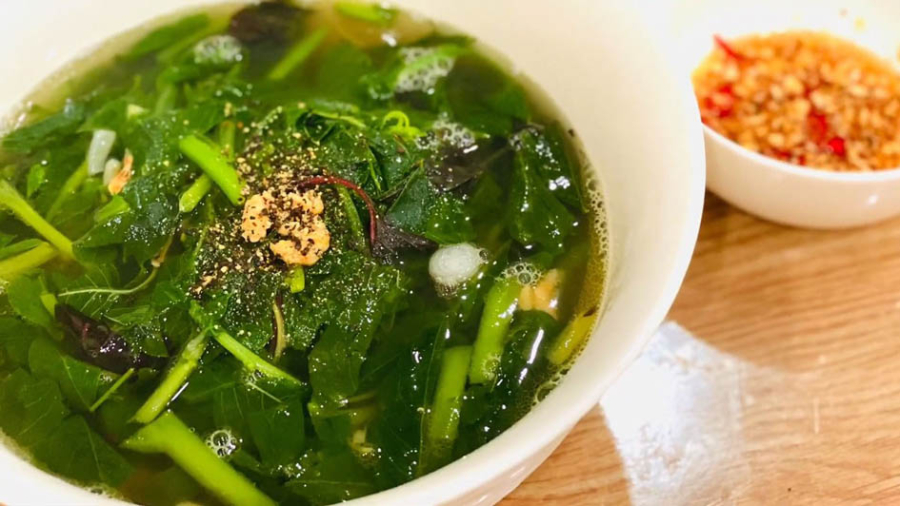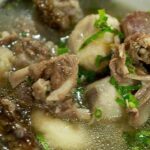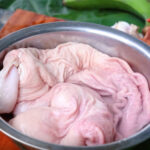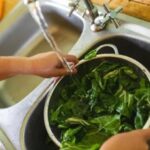The term ‘tap tang’ collectively refers to a variety of vegetables, including rau má, dền gai, sam, ma de, mồng tơi, bồ ngót, lá lốt, trai, ngò tau, ngổ, and éo. These vegetables used to be readily available in gardens and fields, but now even the wealthy crave them.
The flavor of the tap tang vegetable soup remains unforgettable.
Simply wander into your backyard or along the edges of rice paddies and cornfields, and you’ll quickly gather a basketful of wild vegetables like dền, sam, vòi voi, and chay for your mother or grandmother. All these assorted vegetables are then washed, thrown into a pot, and cooked together to create a delicious and memorable soup, seasoned simply with a bit of salt, MSG, dried shrimp or small river shrimp, some scallions, and pepper. The addition of river crab elevates this tap tang soup to another level of deliciousness.

To qualify as tap tang soup, the pot must contain at least three to four different types of wild vegetables. Sometimes, tap tang soup is a combination of these vegetables with young squash and gourd leaves, rau má, bồ ngót, or a few blossoms of squash or chrysanthemum flowers. The more diverse the vegetables, the sweeter and more delicious the soup becomes.
Preparing tap tang soup may seem straightforward, but it requires a bit of a “secret” technique to get it just right; otherwise, it might turn out too salty or bland, or the vegetables could be overly pungent. To make delicious tap tang soup, you must carefully season it to taste, without adding any oil or fat. When the water boils, add the vegetables and cook over high heat to retain their vibrant green color.
Analyzing the nutritional content of these tap tang vegetables reveals a wealth of vitamins, including A, C, and E, as well as calcium and fiber. These vegetables help the body eliminate excess fat, limit fat accumulation, and maintain a balanced weight.
Consuming tap tang vegetables inadvertently provides a fourth essential food group—carbohydrates, fats, proteins, and minerals, fiber, and vitamins—in a balanced way.
The authentic way to cook delicious tap tang soup
Tap tang is a collection of various vegetables, and the cook must know which ones cook quickly and which ones take longer to determine the right time to add them to the pot, ensuring that the water and vegetables are perfectly cooked and blended.
The cooking process is not complicated. Wash the vegetables and let them air dry. Clean the freshly caught shrimp, river shrimp, and river crab, removing their shells and marinating them with fish sauce, scallions, and pepper.

Sauté some scallions with a bit of chili for color, then add the marinated shrimp and stir-fry. Next, add a small amount of ruốc (a type of fermented shrimp paste) diluted with water, stirring for about two to three minutes before pouring in cold water according to the amount of vegetables. Simmer over medium heat to prevent the water from boiling too vigorously and becoming cloudy.
When the water boils, add the vegetables in order of their tenderness: first bồ ngót, then perhaps rau lang, rau má, mồng tơi, and ma de. Once these vegetables are just cooked, add la lot, rau sam, and ngò tau, gently mixing to ensure they are all perfectly al dente.
Tap tang soup can be enjoyed hot or cold with rice, braised meat, or mắm kho quẹt (a traditional Vietnamese dipping sauce). A little spice makes it even better.
“The Ultimate Guide to Cooking Fish: A Delicious and Healthy Treat”
With this fish stew recipe, you’ll discover a delicious and hearty dish that will keep your family coming back for more. The tender fish, infused with a perfect blend of spices, creates a mouthwatering aroma that fills your home. It’s a true delight for the senses and a wonderful way to enjoy a healthy and satisfying meal.
How to Make Delicious and Easy Seaweed Rice Balls
Rice balls with sesame salt, a traditional Vietnamese dish, is a delicious and wholesome treat, which has now become a specialty in urban areas. This simple dish, with its unique blend of flavors and textures, is a favorite among many, especially those with a taste for rustic, hearty cuisine. The rice balls are easy to make, yet they offer a satisfying and flavorful experience, making them a popular choice for those seeking a quick, tasty meal.
The Ultimate Guide to Cleaning a Pig’s Stomach: A Simple Yet Effective Method!
The art of preparing pork stomach for culinary delights is a delicate process that demands attention to detail. It is imperative to meticulously clean and prepare the stomach to eliminate any unpleasant odors that may linger. This crucial step ensures that the final dish is not only tasty but also free from any undesirable smells that could ruin the dining experience.
Should You Wring Vegetables Before Making Soup?
Introducing the Art of Culinary Perfection: Unveiling the Truth Behind a Simple Ritual.
The act of rinsing vegetables before cooking soup is a customary practice for many, but does this ritual impact the essence of the dish? It’s time to explore the intricacies of this culinary custom and unravel the mysteries that lie beneath this simple act. Prepare to embark on a journey where we dissect the art of cooking, one rinse at a time.






































